Friday, November 15th, 2013
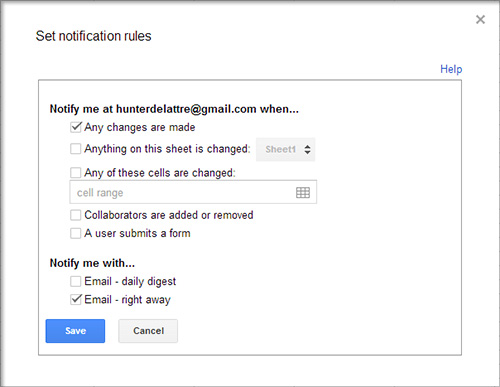
Google Drive’s spreadsheets are liable to be shared and edited by many people.
This can potentially compromise the integrity of their data, so it’s a good idea to keep track of the changes made. Fortunately, Google provides a notifications service so the spreadsheet’s owner can do just that.
To access the notification rules, open the spreadsheet you want to track and select Tools > Notification Rules…. The resulting dialogue allows you to choose what changes to track. If only some data is critical, you can choose to only track a specific sheet or cell range. If you’ve set up a form to feed its result into your spreadsheet, you can choose to be notified whenever somebody submits the form. Choosing email – daily digest will add the notification to a daily email that contains all of your notifications that have this rule selected. Email – right away immediately sends the specific notification to you.
Click Save when you are done. Your new notification rule will be the first on a list of all the notification rules for that spreadsheet. From the list you can add new rules, or edit or delete an existing one.
Helen Bradley
Labels: change, form, google docs, google drive, notification, shared, spreadsheet
Categories:hunter, office
posted by Hunter Delattre @ 9:00 amNo Comments links to this post
Wednesday, November 13th, 2013
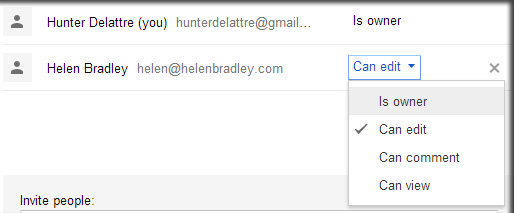
So you’ve decided of your documents is better of in somebody else’s hands. Maybe you prepared the document for a colleague with the intention of handing it off to them later, or maybe you’re just offloading some of your work. Whatever the case, Google makes transferring ownership of your files extremely simple.
To begin, you must first share the file with its new owner. Either click the blue share button in the top right corner of the document, or select File > Share…. When the share menu appears, enter the new owner’s email address and press Share & Save to share the file with them.
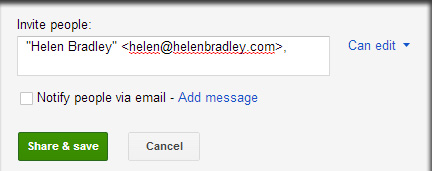
Their address should now be listed in the share menu. Click the can edit box next to their name, select is owner, then click Save Changes. The new owner will be notified by email about the ownership change, and you will still have editing privileges as long as the new owner allows it.
Helen Bradley
Labels: change, google drive, owner, share, transfer
Categories:hunter, office
posted by Hunter Delattre @ 9:00 amNo Comments links to this post
Sunday, November 10th, 2013

Sometimes you know what you want but you don’t know where to find it. Google Docs’ menus are pretty simple, but the Search the menus tool can make menus entirely obsolete. You can find this search tool under the Help menu, but it can be more easily reached by pressing Alt + /.
This search tool is extremely powerful. Type anything related to what you want and it’s almost guaranteed to appear, from basic settings to specific font settings. Search “math” and you’ll see the option to insert a new a equation, “double” will yield the double line space setting, “list” will provide many different types of lists you can insert.
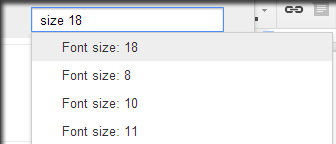
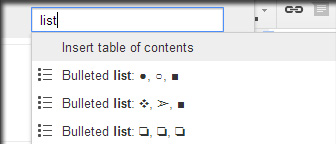
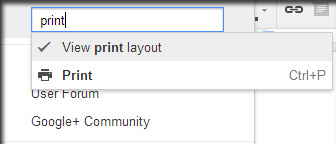
Almost every setting can be tweaked from this search menu. Next time you’re lost in the settings menus, just pressing Alt + / and find what you want in seconds.
Helen Bradley
Labels: document, Find, google docs, google drive, menu, search
Categories:hunter, office
posted by Hunter Delattre @ 9:00 am2 Comments links to this post
Wednesday, October 30th, 2013

You’ll often discover that copy-pasted text from other parts of the web does not match the font styling of your document.
For example, you may copy a quote from an article and find it in 10 pt and a different font or color. Google Doc’s new paint format tool solves this problem by letting you instantly match foreign text’s style to your own by copying the formatting from one set of text to another.
To use it, select any of the text from your own document and select the paint roller icon from the left side of the toolbar. The selected text’s styling will be saved in the paint tool, and the next body of text you select will have the styling “pasted” onto it such that the foreign text now matches your own. So, with the template text and paint tool selected, select the text with incorrect styling and it will be fixed instantly.
Helen Bradley
Labels: font, format painter, google docs, google drive, match font, paint formatter, text, word processor
Categories:hunter, office
posted by Hunter Delattre @ 9:00 amNo Comments links to this post
Sunday, October 27th, 2013
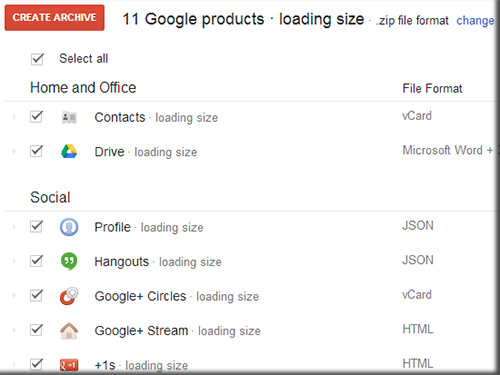
If you rely on many of Google’s products, you may have stored a lot of important data on your account.
Even though Google’s servers are very reliable, it’s still a good idea to backup your critical documents, photos, messages, etc. Fortunately, Google provides a service called Google Takeout which provides a quick and easy way to backup everything on your Google account, even your Google+ circles and pages. The service can be found under your account settings, labeled download your data. You can also find it at this link.
At the Takeout page you’ll find a full list of what is being archived. You can uncheck anything you don’t need to save. If you click on a category, a list of settings will appear for that category. Sometimes no changes can be made, but some categories allow you to change their archive’s file format. Others allow you to filter what you want to save, so that only specific data—such as a certain folder in your documents library—will be archived.
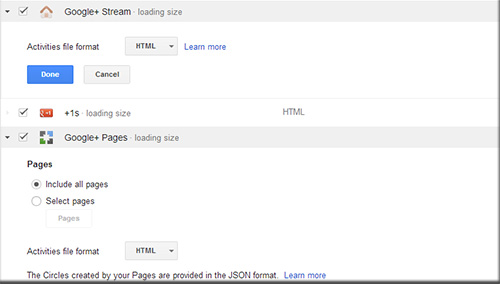
Once you have selected your desired settings, click “Create Archive.” If your account includes a lot of data, it may take a while to finish generating the archive. You can leave the page, however, and Google will email you when the archive is ready for download so you don’t have to wait around for it. To finish the process simply follow the provided download link to download your Google profile archive.
Helen Bradley
Labels: archive, backup, google, google docs, messages, Profile
Categories:hunter, office
posted by Hunter Delattre @ 9:00 amNo Comments links to this post
Sunday, October 20th, 2013
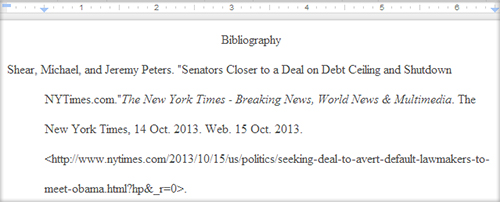
If you’re writing a paper with a bibliography or works cited page in Google Docs, you may be frustrated to find there’s no formatting button for hanging indents.
You can create these manually, however, using Doc’s ruler tool. If the ruler is not already visible, select View > Show Ruler. It will appear across the top of your document.
To create your hanging indent, first select the text you wish to add the indent to. Notice two small blue shapes on the left side of the ruler, a triangle and rectangle.
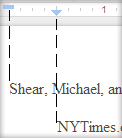
The rectangle represents your left margin, the triangle your indent. There is also a grey section of the ruler that shows you the standard 1 inch margin. Move the triangle to 1/2 inch right of the left margin. Keep in mind that while a 1/2 inch indent is standard, you should adjust this if a different sized indent is required. Now pull the rectangle back to the original left margin. You should see your text move with these shapes such that the text’s margin aligns to the rectangle and the hanging indent aligns with the triangle.Keep in mind that just like any other formatting choice, this indent will only be applied to text you’ve selected or text written following the change.
Helen Bradley
Labels: bibiolography, citation, google docs, hanging indent, indent, works cited
Categories:hunter, office
posted by Hunter Delattre @ 9:00 amNo Comments links to this post
Monday, September 30th, 2013

When creating a long document with many different sections, it’s often necessary to create a table of contents to make navigation easy. Fortunately, Google Docs can generate a table for you almost entirely automatically.
To do this, you must first create section headers using the list under Format > Paragraph Styles. Simply highlight a section title and apply an appropriate heading style for it. Each style grows progressively smaller from 1 to 6. Major sections, such as chapters, should use the largest headings while smaller subsections should use progressively smaller headings.
Once you have created all of your headings, select where you want the table of contents to be in your document and choose Insert > Table of Contents. The table will automatically fill with links to each heading and arrange itself according to the heading styles chosen. Smaller headings will be indented beneath larger headings in the table, indicating that they are subsections.
Helen Bradley
Labels: automatic, google docs, organize, table of contents
Categories:hunter, office
posted by Hunter Delattre @ 9:00 amNo Comments links to this post
Saturday, May 18th, 2013

You can easily enable offline viewing of any Google Docs documents. By default this ability is turned off, so you may want to enable it for emergency situations if you rely on Google Docs for viewing and editing important files. Keep in mind that you must be using Google’s Chrome web browser to do this. Chrome can be downloaded here. Also note spreadsheets can only be viewed, not edited, using this method.
To do this, go to your Google Drive and click the More button along the left side, under the Create button. This will open a small dropdown menu that includes the Offline option. Select this, and then follow the simple instructions to enable offline mode. This really involves just two clicks and some waiting. Once you have selected the Enable Offline button, you’ll have to wait some time so that all of your documents can be downloaded to your computer for offline storage. All offline documents will be listed in the Offline section once this is done.
If you want to disable offline editing for any reason, simply click the gear icon toward the top right of Google Drive and select Disable offline.


Helen Bradley
Labels: documents, editing, google docs, mode, offline, viewing, work
Categories:hunter, office
posted by Hunter Delattre @ 9:00 amNo Comments links to this post
Wednesday, May 15th, 2013
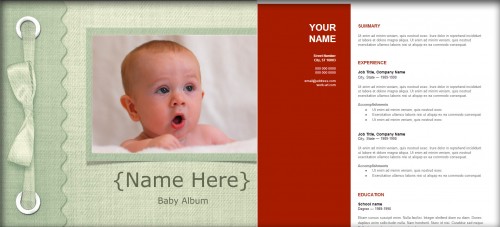
When creating a new presentation or document in Google Docs, you might find that the default templates don’t provide the theme you want. Fortunately, Google provides an easy way to find the perfect template for your situation, from baby photo albums to résumés. To find a template suitable for you, simply visit https://drive.google.com/templates?view=public. You can search by name, category, and popularity to quickly find whatever you need.
Once you’ve selected a template you like, simply click the Use this template button and a new document will automatically open with the chosen template, ready for use.
Helen Bradley
Labels: google docs, new, resume, search, templates
Categories:hunter, office
posted by Hunter Delattre @ 9:00 amNo Comments links to this post
Monday, May 13th, 2013

If you like working with the cleanest view possible, Google Docs makes it easy for you. First select View > Full screen. This will remove all menus from the screen, so make sure you don’t need to access any buttons while using this view. Now you can make your browser itself full screen. In most browsers you can accomplish this by pressing F11. With these options you will see absolutely nothing but the page you are typing on.
To undo these options, press F11 again to eliminate the browser full screen, then esc to eliminate Google Doc’s full screen mode.
Helen Bradley
Labels: full screen, google docs, maximum, space
Categories:hunter, office
posted by Hunter Delattre @ 9:00 amNo Comments links to this post



















